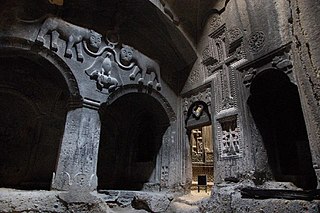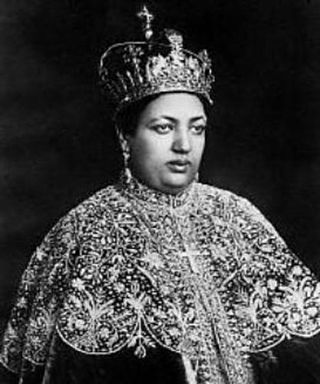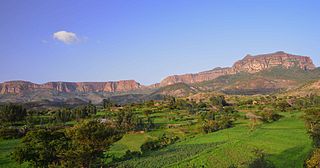Related Research Articles

A monolithic church or rock-hewn church is a church made from a single block of stone. Because freestanding rocks of sufficient size are rare, such edifices are usually hewn into the ground or into the side of a hill or mountain. They can be of comparable architectural complexity to constructed buildings.

Lalibela is a town in the Amhara Region of Ethiopia. Located in the Lasta district and North Wollo Zone, it is a tourist site for its famous rock-cut monolithic churches designed in contrast to the earlier monolithic churches in Ethiopia. The whole of Lalibela is a large and important site for the antiquity, medieval, and post-medieval civilization of Ethiopia. To Christians, Lalibela is one of Ethiopia's holiest cities, and a center of pilgrimage.

Menen Asfaw was Empress of Ethiopia as the wife of Emperor Haile Selassie.

Princess Tenagnework Haile Selassie, GBE was the eldest child of Emperor Haile Selassie and Empress Menen Asfaw.
Princess Aida Desta, baptismal name Bisrate Gabriel, was the eldest granddaughter of Emperor Haile Selassie, eldest child and daughter of Ras Desta Damtew and Princess Tenagnework. She was the wife of Leul Ras Mangasha Seyum, Prince of Tigray, son of Seyum Mangasha, and great-grandson of Emperor Yohannes IV. Her godmother was Empress Zewditu of Ethiopia.

Princess Seble Desta was a member of the Solomonic dynasty, which ruled Ethiopia until 1974. She was born in Addis Ababa, Ethiopia, and was the daughter of Princess Tenagnework Haile Selassie and Ras Desta Damtew, and granddaughter of Emperor Haile Selassie of Ethiopia and Empress Menen Asfaw. Princess Seble's paternal grandfather, Fitawrari Damtew Ketema, was martyred during the Ethiopian victory against the Italians at Adwa.
Princess Sophia Desta was the youngest daughter of Ras Desta Damtew and Princess Tenagnework Haile Selassie, and granddaughter of Emperor Haile Selassie I of Ethiopia. She was educated at Clarendon School for Girls in the United Kingdom together with her three sisters, Aida, Hirut Desta (Ruth) and Sebel. Princess Sophia was imprisoned, mistreated and humiliated in the Alem Bekagn Kerchele prison, Addis Ababa together with her sisters, other princesses of the Imperial Family, from 1974 until 1988.

Princess Hirut Desta was the daughter of Ras Desta Damtew and Princess Tenagnework Haile Selassie, and granddaughter of Emperor Haile Selassie of Ethiopia. She was the widow of General Nega Tegegn, who was governor of the provinces of Begemder and Semien. She was described by Nathaniel T. Kenney as a "trim, most democratic of princesses," who "was not above grabbing a tool from a workman, I suspect, and showing him how to use it."
Medferiashwork Abebe, baptismal name Amete Maryam, was the titular empress consort of Amha Selassie, emperor-in-exile of Ethiopia. Her full title used by monarchists was "Her Imperial Majesty, Empress Medferiashwork", but she was officially regarded in post-Derg Ethiopia as "Her Imperial Highness Princess Medferiashwork Abebe".

Kola Tembien is a woreda in Tigray Region, Ethiopia. It is named in part after the former province of Tembien. Part of the Mehakelegnaw Zone, Kola Tembien is bordered on the south by Abergele, on the west by the Tekezé River which separates it from the Semien Mi'irabawi Zone, on the north by the Wari River which separates it from Naeder Adet and Werie Lehe, on the east by Misraqawi (Eastern) Zone, and on the southeast by Degua Tembien. Towns in Kola Tembien include Guya and Werkamba. The town of Abiy Addi is surrounded by Kola Tembien.

Werie Lehe was one of the woredas in the Tigray Region of Ethiopia. Part of the Maekelay Zone, Werie Lehe was bordered on the south by the Wari River which separated it from Kola Tembien, on the southwest by Naeder Adet, on the west by La'ilay Maychew, on the north by Adwa, on the northeast by Enticho, and on the east by the Misraqawi (Eastern) Zone.

Aïda Muluneh Ethiopian photographer, educator, and entrepreneur known for her Afrofuturist photography that incorporates vibrant colours and body painting to create surreal scenes.

Dame Jane Drew, was an English modernist architect and town planner. She qualified at the Architectural Association School in London, and prior to World War II became one of the leading exponents of the Modern Movement in London.
Le'ul RasMengesha Seyoum is a member of the imperial family of the Ethiopian Empire. In 1974, the monarchy was abolished by the Derg, a communist military junta.

Wukro Chirkos is an Orthodox Tewahedo monolithic church located in northern Ethiopia, on the northern edge of the town of Wukro near the main highway. From the time members of the 1868 British Expedition to Abyssinia reported its existence until the early 20th century, it was the only rock-hewn church known to the outside world.
Wkro Mariyam is a monolithic church in northern Ethiopia. It is one of several churches located, in a remote region known as Amba Senneyti outside of the town of Nebelet, which is in the Mehakelegnaw Zone of the Tigray Region. It was first mentioned by the Catholic historian Manoel Barradas, whose Tractatus Tres Historico-Geographici was published in 1634. Its first modern description was published by Professor A. Mordini published a description of it in 1939.
Sidney John Alexander Churchill, often referred to as Sidney J. A. Churchill, was a British diplomat, art connoisseur and author.
Clarendon School for Girls was a girls' independent boarding school, which began in 1898 in Malvern, Worcestershire, England. It moved three times: first to Kinmel Hall near Abergele in Denbighshire in 1948 and then to Haynes Park in Bedfordshire in 1976 before merging with Monkton Combe School, near Bath, Somerset in 1992.

The Adigrat Sandstone formation in north Ethiopia, in a wide array of reddish colours, comprises sandstones with coarse to fine grains, and locally conglomerates, silt- and claystones. Given the many lateritic palaeosols and locally fossil wood fragments, the formation is interpreted as a deposit in estuarine, lacustrine-deltaic or continental environments. The upper limit of Adigrat Sandstone is of Middle-Late Jurassic age whereas the lower boundary is Triassic. There are numerous rock-hewn churches in this formation.

Tanqua Millash is a district in the Tigray Region of Ethiopia. Located in the Central Tigray zone, Tanqua Millash was created from parts of the Tanqua Abergelle and Dogu’a Tembien in 2020. Agbe is the capital of this district.